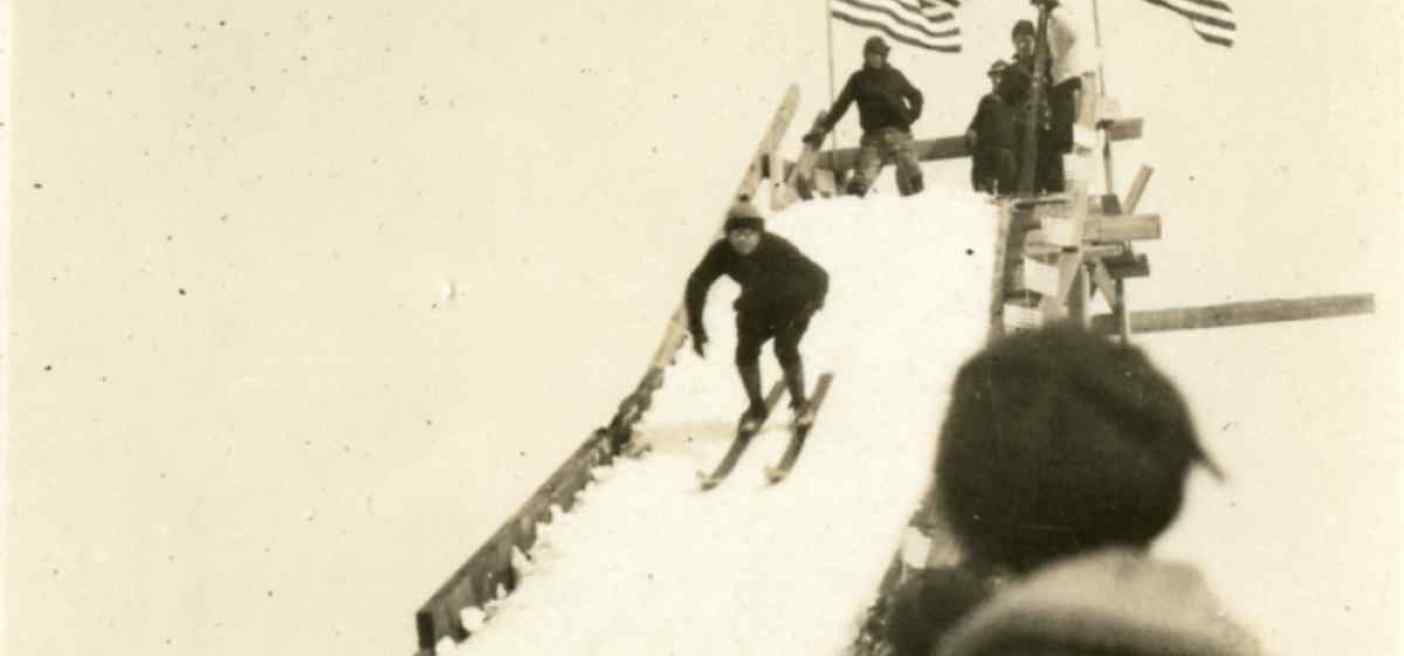Ski Jumping in Marathon County

In the late 1920s, the Wausau area became the home of an exciting new trend in winter sports; the ski jump. It began in December of 1926, when the Wisconsin Valley Improvement company built a modest ski jump at Rothschild Park. The park had recently become home to a number of modern recreational options—from skating rinks, baseball fields, a wooden rollercoaster, a swimming area, to the iconic Rothschild Pavilion—all connected to the greater Wausau area by the electric trolley system that allowed for daytrips to the recreation hotspot that was Rothschild Park.

[Above] The first ski jump was built next to the Rothschild Pavilion in 1926. The jumpers traveled over the trolley tracks and jumped towards the frozen Lake Wausau.
The ski jump had been built just in time to feature prominently in a new event being planned in Wausau. The Wausau Winter Frolic would be a staple of the winter lives of area residents for generations. The event usually featured a parade and the crowning of a Frolic Queen, but the main attraction was the winter sporting events. There were events for skating, hockey, curling, cross-country skiing, tobogganing, horse racing, target and trap shooting, and a dog derby. But the highlight for many of the spectators and participants who turned up for the first year's events was the ski jumping.

If done correctly, the fearless young men could briefly take flight off the jump, soaring up to 60 feet in the air. If done incorrectly, they could tumble violently down the slope after leaving the slide at speeds of up to 50 miles an hour. Either way, the crowds who turned out to watch were delighted. In 1927 some 3,000 spectators were present when Hans Troye of the University of Wisconsin and Chester Hassler “of Scandinavia” pushed the jump record for the slide to 62 feet.
The Souvenir Booklet produced after the first Winter Frolic in 1927 noted:
The Winter Frolic brought forcibly to the attention of Wausau people the possibilities of ski jumping and cross country ski races. Never before had such stress been put forth in this kind of cold weather outdoor sport, and few realized that this city had such a large number of ardent devotees. While it is true that outsiders did the best work in form and distance jumping as well as speed in runs, the local people did not have the opportunity to acquire fineness. What they accomplished at the Frolic was the result of a few week’s practice on the Rothschild park slide, erected a short time previous. Next year will undoubtedly see better local performers and possibly keener competition with the outsiders, and eventually windup with the erection of a larger slide. However, winter sports leaders declare that the distance jumping is not the big thing; it is the gracefulness that is the feature of the jump.
Soon other ski jumps would be built in the area. In late 1929 a bigger slide was erected by the Wausau Ski Club (who had been formed two years earlier) off Stark Street in Wausau. It was said to be among the largest ski jumps in the State of Wisconsin for its time.

[Above] The Stark Street Jump, during the 1930 Wausau Winter Frolics.
A smaller jump was built on the west bank of the river in Wausau as well, near the Curtis & Yale Plant. And while it was smaller in scale than the Rothschild or Stark Street runs, this slide was said to have been very popular among beginners and helped to bring more people into the sport.

[Above] The smaller jump built near the Curtis & Yale Plant was helpful for beginning jumpers.
By the end of the 1930s, interest in ski jumping was waning, particularly in light of the development of downhill skiing at Rib Mountain. The hill provided a great deal of potential for skiing enthusiasts, especially after the Wausau Chamber of Commerce worked out a deal with the Wisconsin Conservation department and the National Park Service to develop the facilities for skiers. By 1939, Wausau could boast of six trails encompassing a slope of 2500 feet long and 400 wide. It had a warming house, equipment rental and instruction services for new skiers, and a state of the art ski tow that could hold up to 75 people at a time (the “Finest Ski Tow in the Middlewest”). The hill had become so popular that there were “snow train” railroad lines that brought in skiers from Chicago and Milwaukee each weekend during the skiing season.

[Above] An advertizement for Rib Mountain from 1939.
In an oral history interview from 2008, Russell “Spike” Berg described the ski jumping era as a time when “everybody went straight on skis … they weren’t turning.” But after the 1936 Winter Olympics introduced slalom and downhill races, skiers learned to turn while going downhill. Developments in ski equipment helped this transition, as shorter skies and better bindings allowed more technical movements while racing downhill. And ultimately downhill skiing, was more approachable to the average person. It might not have been as interesting to the spectators as ski jumping had been, but it was far easier to learn to do yourself. So as Rib Mountain’s downhill slopes were developed, the Wausau Ski Club focused their attention on promoting downhill instead of jumping. As a result, their membership grew steadily through the late 1930s.
But though the crowds were less likely to come out in force to see them jump in the late 1930s and early 1940s, the Wausau ski jumpers continued to launch themselves into the air. And by the end of the 1940s, a renewed interest in ski jumping would return to Marathon County. In 1949 this led to the creation of the most ambitious ski jump yet built in the area, in the paper mill town of Brokaw.
Read Part Two of the history of ski jumping in Marathon County
